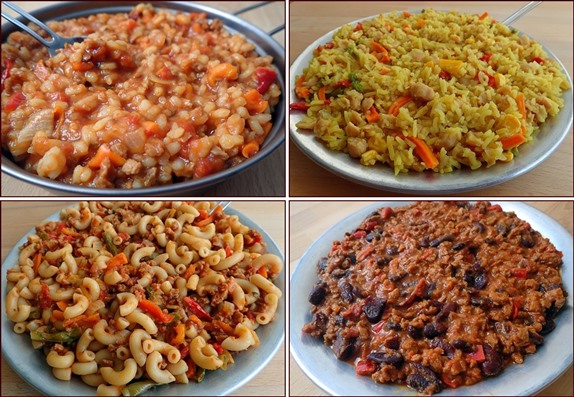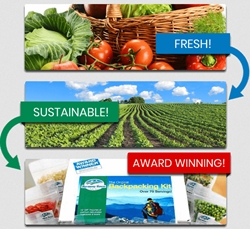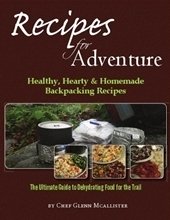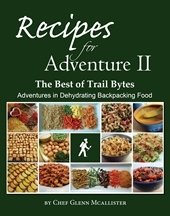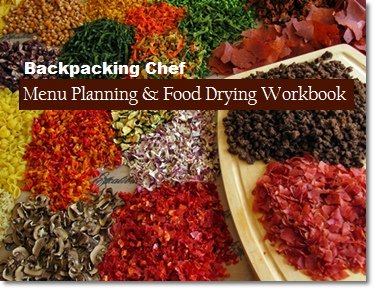Textured Vegetable Protein Recipes (TVP)
The textured vegetable protein recipes on this page demonstrate how to make backpacking and emergency meals using TVP as the primary protein source.
Recipes at Backpacking Chef usually include three components—starch, vegetable, and meat—just like meals at home. If you want to eat less meat, but still enjoy its chewy texture in meals, recipes can be adjusted by substituting textured vegetable protein for meat.
Table of Contents
What is Textured Vegetable Protein (TVP)?
Is Textured Vegetable Protein Healthy?
Benefits and Drawbacks of Using TVP in Meals
Converting Meat Recipes to TVP Recipes.
Rehydrating Textured Vegetable Protein Recipes.
TVP Recipes:
What is Textured Vegetable Protein (TVP)?
Textured vegetable protein is made by removing the oil from soy beans. The resulting soy flour has no fat and is high in protein and fiber. TVP is shaped into flakes, bits, or nuggets using a high-temperature extrusion process. It can be purchased flavored or unflavored. Unflavored TVP may be darkened with caramel color to resemble beef, whereas TVP without caramel color will appear more like chicken.
Is Textured Vegetable Protein Healthy?
Top-ranked food and health websites give TVP the green light as a healthy alternative to meat. In addition to being high in protein, TVP is high in fiber, which is lacking in real meat. Some people may be allergic to soy, the primary ingredient in TVP. Two Backpacking Chef Facebook commenters reported that TVP gives them gas.
After experimenting with the textured vegetable protein recipes on this page, I can report that all went well for me in the digestion department. Nevertheless, it’s a good idea to test these TVP recipes at home before hitting the trail.
Positive reference: Livestrong.com Is TVP Healthy?
Some sources contend that TVP is not healthy because it is a processed food, rather than a whole food. They point out the chemical process used to separate soy solids from oil, and the high temperatures applied during extrusion.
Negative reference: Evolvingwellnes.com What You Need to Know about Textured Vegetable Protein.
If you decide to give textured vegetable protein recipes a try, there are other considerations:
Benefits of Using TVP in Meals
- TVP compares favorably to meat for texture.
- TVP is easy to use “as is” in backpacking meals, so it saves time compared to precooking and dehydrating meat.
- TVP can be stored for years in its unopened, original container.
- TVP contains no fat, so there is no risk of it going rancid.
- TVP costs less than meat.
Drawbacks of Using TVP in Meals
- TVP contains no fat. While this is a benefit for storage, a lack of fat reduces the energy potential in the meals.
- TVP lacks real meat flavor, partly due to the missing fat. But it readily absorbs flavors from meals that include chili, taco, and curry seasonings; or tomato sauce, soy sauce, and cheese sauce.
Converting Meat Recipes to TVP Recipes
Many backpacking recipes include either a ¼-cup or a ⅓-cup of dried ground beef or chicken.
Make it a TVP recipe by exchanging an equal volume of textured vegetable protein.
- ¼-cup dried ground beef or chicken weighs 30 grams.
- ¼-cup beef or chicken-flavored TVP weighs 25 grams.
- ⅓-cup dried ground beef or chicken weighs 40 grams.
- ⅓-cup beef or chicken-flavored TVP weighs 33 grams.
Rehydrating Textured Vegetable Protein Recipes
Although TVP weighs a little less than dried meat, it absorbs twice as much water when you rehydrate it in meals.
When substituting TVP for dried meat in a recipe, use an additional amount of water equal to the volume of the TVP used.
Example:
Recipe with dried ground beef: ½ cup dried rice, ¼ cup dried vegetables, ¼ cup dried ground beef—rehydrate with 1 cup water.
Recipe with TVP: ½ cup dried rice, ¼ cup dried vegetables, ¼ cup TVP—rehydrate with 1¼ cup water.
Textured Vegetable Protein Recipes
TVP Chili Recipe
In this TVP recipe, the whole meal is cooked and then dehydrated. The first step is to rehydrate the TVP with warm water so that it replaces approximately one pound of ground beef normally used.
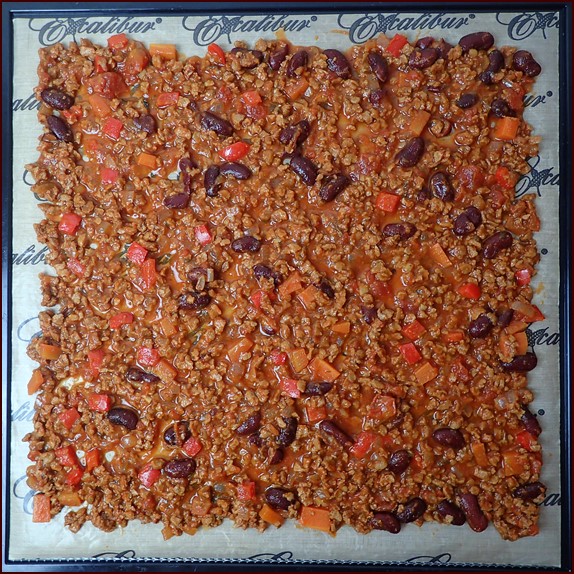
Photo: 2 cups of TVP Chili on Excalibur dehydrator tray. Three trays were used for this recipe.
Makes 6 cups of chili before drying, 4 cups after drying.
Ingredients:
- 1½ cup beef-flavored TVP (150 g)
- 1½ cup warm water to rehydrate TVP (355 ml)
- 1 can red beans (300 g)
- 1 can diced tomatoes (400 g)
- 3 small onions, diced (130 g)
- 2 cloves garlic, minced (12 g)
- 1 carrot, diced (70 g)
- 1 bell pepper, diced (140 g)
- 3 Tbsp. chili mix powder
- 3 Tbsp. tomato paste
- 2 Tbsp. dried parsley
- 1½ tsp. salt
- 1 tsp. cumin
- 1½ cup water
Prepare the Chili:
Rehydrate 1½ cups TVP with 1½ cups warm water in a bowl and set aside.
The vegetables in this chili recipe are cooked in water, rather than oil.
Cut up all the vegetables and place in pot with all seasonings. Hold back the beans and TVP.
Add 1½ cups water and bring to a boil. Continue cooking on low simmer for 10 minutes.
Add beans and rehydrated TVP. Continue cooking another 10 minutes, then set pot off the heat until it cools.
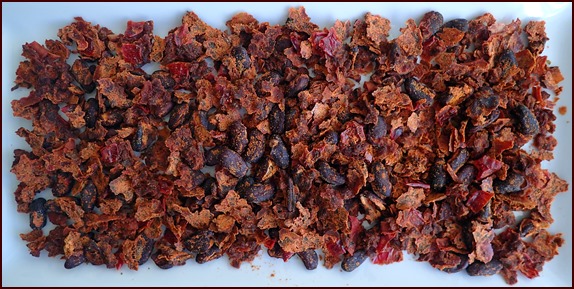
Photo: dehydrated TVP Chili.
Dehydration:
Spread chili on dehydrator trays covered with nonstick sheets. Dehydrate at 145°F (63°C) for approximately eight hours, or until no moisture remains.
Yields: This recipe yields approximately 6 cups wet, and reduces down to 4 cups dried. Approximate dried weight is 300 grams.
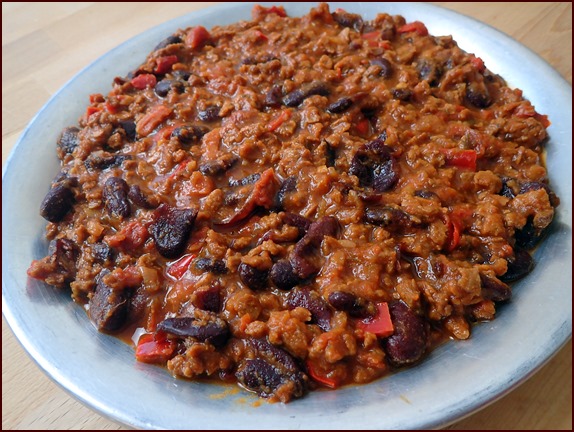
Photo: rehydrated TVP Chili.
On the Trail:
Servings: 1
Ingredients:
- 1⅓ cup dried chili (100 g)
- 1½ cup water to rehydrate (355 ml)
Combine dried chili with water and soak for 5 minutes. Bring to a boil for one minute. Transfer pot to an insulated pot cozy for fifteen minutes. This meal also rehydrates well in a thermos food jar.
Textured Vegetable Protein Recipes with Tomato Sauce
Unstuffed Peppers with TVP
In this TVP recipe, the TVP is used “as is” in combination with dried rice, bell peppers, and tomato sauce leather.
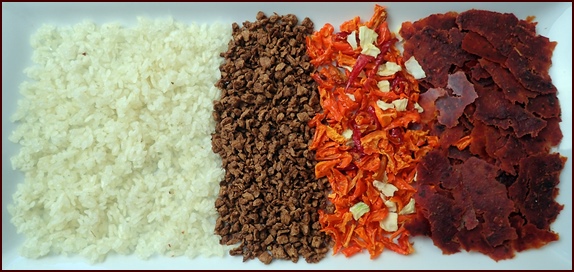
Servings: 1
Ingredients:
- ½ cup dried rice (55 g)
- ¼ cup beef-flavored TVP (25 g)
- ¼ cup dried bell peppers (15 g)
- ¼ cup tomato sauce leather (15 g)
- 1½ cup water to rehydrate
Pack tomato sauce leather in a separate bag.
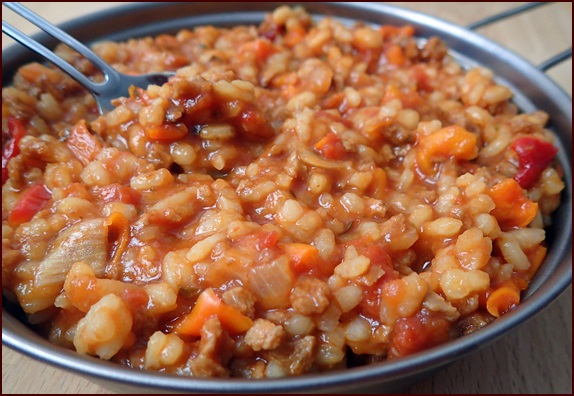
Photo: TVP Unstuffed Peppers rehydrated.
On the Trail:
Combine ingredients with water and soak for 5 minutes. Bring to a boil for one minute. Transfer pot to an insulating pot cozy and wait about fifteen minutes before serving. This meal also rehydrates well in a thermos food jar.
Mac & Veggies with TVP
Because this textured vegetable protein recipe includes tomato sauce as a flavor unifier, you can use unflavored TVP, or you can experiment with beef or sausage-flavored TVP.
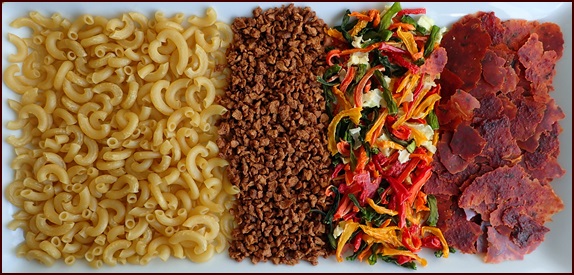
Servings: 1 large
Ingredients:
- ¾ cup dried macaroni (80 g)
- ⅓ cup beef or sausage-flavored TVP (33 g)
- ⅓ cup dried mixed vegetables (20 g)
- ⅓ cup tomato sauce leather (20 g)
- 2 cups water to rehydrate (473 ml)
Pack tomato sauce in a separate bag.
On the Trail:
Combine ingredients with water and soak for 5 minutes. Bring to a boil for one minute. Transfer pot to an insulating pot cozy and wait about fifteen minutes before serving. This meal also rehydrates well in a thermos food jar.
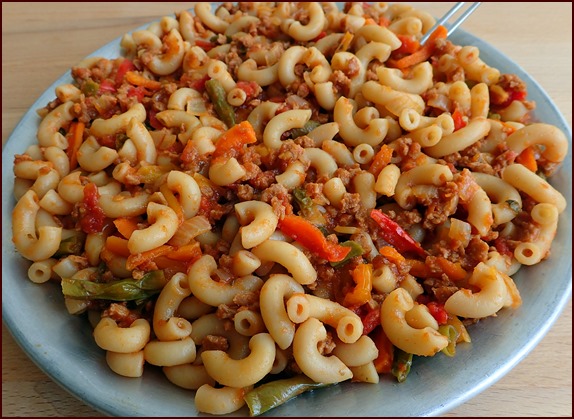
Photo: Mac & Veggies with TVP rehydrated.
TVP Recipe with Curry-Seasoned Basmati Rice
Curry Rice & Vegetables with TVP
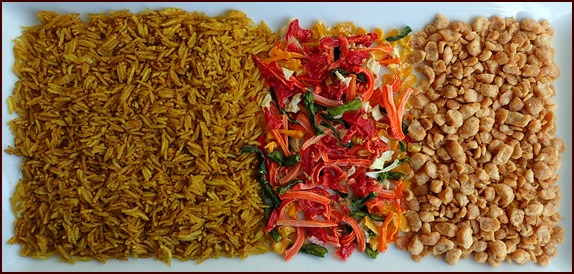
Photo: Chicken-Flavored TVP Bits on right.
Servings: 1 large
Ingredients:
- ¾ cup curry-seasoned dried basmati rice (80 g)
- ⅓ cup chicken-flavored TVP (33 g)
- ⅓ cup dried mixed vegetables (20 g)
- 2 cups water to rehydrate (473 ml)
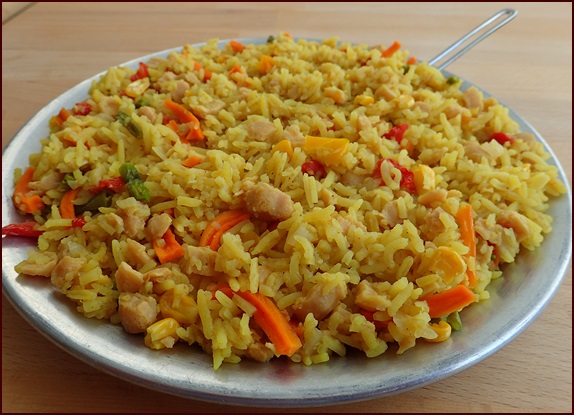
Photo: Rehydrated Curry Rice & Vegetables with TVP.
On the Trail:
Combine ingredients with water and soak for 5 minutes. Bring to a boil for one minute. Transfer pot to an insulating pot cozy and wait about fifteen minutes before serving. This meal also rehydrates well in a thermos food jar.
Source for Textured Vegetable Protein
I purchased the TVP used in the above textured vegetable protein recipes from Harmony House Foods. They offer unflavored TVP, or TVP flavored to taste like beef, chicken, taco, sausage, bacon, and chorizo.
The flavored varieties are called “Flavored Bits.”
The unflavored TVP products are called “Beef-Style Bits” or “Chicken-Style Bits.” The only difference between the two is that the Beef-Style Bits have caramel coloring to make them beef-colored.
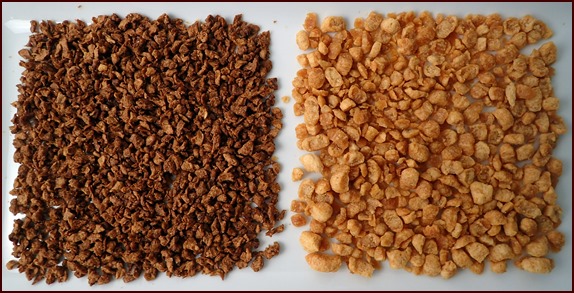
Photo: Beef-Flavored Bits (L) and Chicken-Flavored Bits (R) used in the featured TVP recipes.
I prefer the texture of Chicken-Flavored Bits compared to Chicken-Style Bits. The Chicken-Flavored Bits are a little chunkier. The texture of Beef-Flavored Bits is very similar to unflavored Beef-Style Bits, so I’ll go with the unflavored version next time.
The flavored offerings are just a so-so match to the real thing, and they include ingredients like sodium and dextrose. You can achieve a similar flavor result in TVP recipes by adding taco seasonings, sausage seasonings, chili mix powder, or curry powder to meals.
For me, texture and high protein are the main benefits of using textured vegetable protein as a meat replacement. As an omnivore, I will continue making backpacking meals with real meat, but I will also include some textured vegetable protein recipes for variety and convenience.
|
Buy Direct from Harmony House Foods |
Disclosure: Backpacking Chef participates in the affiliate program offered by Harmony House Foods. If you make a purchase after following the above link, I may receive a commission. Thank you.
Explore More...
If you have questions or would like to add comments about textured vegetable protein recipes, please contact Chef Glenn.
Share this page with friends on social media.
Free E-book & Newsletter
Free with Trail Bytes subscription.
Dehydrating Food from A–Z

